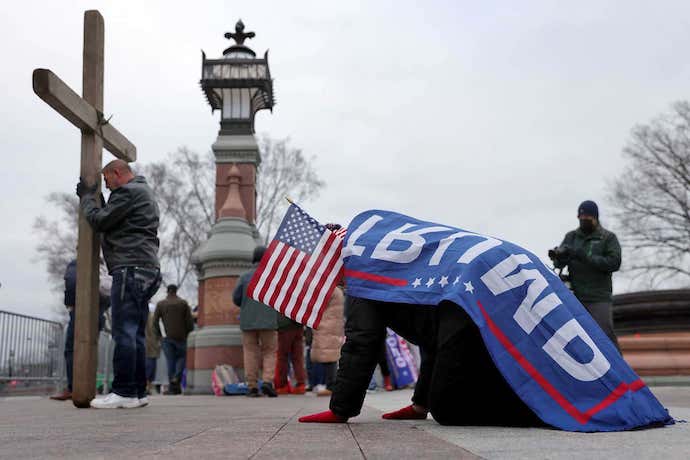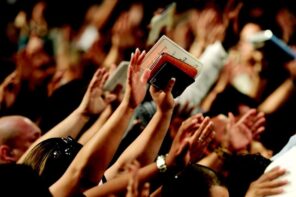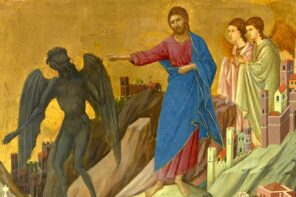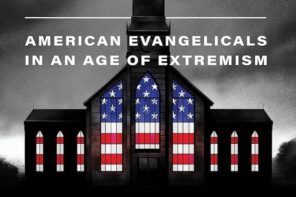As we approach the two-month ‘anniversary’ of the armed takeover of the Capitol, and President Trump’s second impeachment trial on his role in the riot is over, the sense of shock over the prominent participation of evangelicals in the January 6th insurrection remains fresh. “How did we get here?” evangelical leader Ed Stetzer asked, after images of rioters carrying Jesus is my Savior, Trump is my President and other such banners filled the news. “What happened? Why were so many people drawn to somebody who was obviously so not connected to what evangelicals believe by his life or his practices or more?”
The sentiment is a familiar one. The mix of astonishment, bewilderment, and concern it contains has come to define people’s reaction to the unwavering support that the majority of those who identify as evangelical continue to show Donald Trump. From the moment 2016 exit polls revealed that 81% of self-described “born again” Christians voted for the former reality TV star, a veritable cottage industry of editorials, hot takes, and academic research took shape that aimed to account for this supposedly astonishing fact.
Setting aside attempts to “downplay and complicate” evangelical support, journalists found that nostalgia for an imagined pre-Civil Rights America drew many evangelicals to Trump’s promise to “Make America Great Again,” while pollsters discovered that a form of Christian nationalism anchors the political worldview of many others. Yet for all of the good work and vital insights this work has yielded, much of it remains animated by the feeling that many of us likely had as we watched a man dressed in nothing but animal fur, face paint, and white nationalist tattoos pray on the Senate dais: What just happened? How did we get here?
But should we have really been surprised?
I’ve been reflecting upon this sense of incredulity of late. In particular I’ve been wondering about the ways in which the study of evangelicalism itself may have blinded us to those truths that were revealed upon the Capitol steps. Because, as it has become increasingly clear, the majority of those who think of themselves as evangelical support Trump, not in spite of his racism, chauvinism, and Christian nationalism; they support him because evangelicals have long served as one of white supremacy’s greatest allies. Yet for too long the study of evangelicalism has sanitized the political and racial elements of American evangelical history by focusing solely upon its piety and theology. It’s well past time to change that.
The text that crystallized all this for me is a somewhat recent anthology of essays whose chronological scope unintentionally reveals the ways in which the study of evangelicalism has suppressed evangelicalism’s complicity in the making of American whiteness. Titled Evangelicals: Who They Have Been, Are Now, and Could Be, the book brings together some of the most influential pieces of scholarship on evangelicalism from the last forty years and places it alongside a handful of new essays that finally do attempt to grapple with evangelical support for Donald Trump.
Yet in ways that the editors might not have intended, the juxtaposition of these two conversations—the reprints and the new additions—also invites a consideration of the ways in which this body of work might have ill prepared us for this moment. In fact, the sense of surprise that continues to confront evangelical zealotry for Trump might be Noll, Marsden, and Bebbington’s greatest legacy, because the absence of discussions about race, gender, or nationalism in the collection’s reprints is made all the more glaring by their abundance in the book’s newer pieces. And the willful ignorance to these features of American evangelical life suggests that the study of evangelicalism has for too long selectively drawn from the past in order to craft a supposedly true or right version of the faith that may never have existed.
Building walls high enough to keep the “evangelicals” out
The significance of Noll, Marsden, Bebbington’s contributions to the study of evangelicalism is in part based upon their biography. The careers of these three self-identifying evangelicals mirrored evangelicalism’s broader rise in American politics and culture in the 1970s, linking their professional success with their personal faith commitments. Marsden, for instance, taught for more than two decades at a small, conservative Dutch Reformed school before his pioneering work earned him positions at major research universities like Duke and Notre Dame.
Noll, meanwhile, similarly taught for nearly thirty years at Billy Graham’s alma mater, Wheaton College, before succeeding Marsden in South Bend. Bebbington’s career followed a different path as a British scholar and citizen. But his work on evangelicalism in England nonetheless benefitted from America’s sudden interest in this newly public faith. Indeed, Bebbington’s famed four-part description of evangelicalism as bibliocentric, crucicentric, conversionist, and activist has become so widely regarded that the National Association of Evangelicals has adopted it as the preferred description of its members.
The essays that make up Part I of Evangelicals evoke this authorized evangelical historiography. The book opens, for example, with Marsden’s 1984 portrayal of evangelicalism as a kind of “denomination in the sense of a name by which a religious group is denominated,” and includes the first seventeen pages of Bebbington’s famed Evangelicalism in Modern Britain, wherein he laid out his four-part description of evangelicals noted above. This view became the field’s prevailing paradigm, as the remaining reprints of the book’s first part make clear. An old Noll article on social survey data, a recent etymology of the term “evangelical” by historian Linford Fisher, and a roundtable commemorating the twenty-fifth anniversary of Evangelicalism in Modern Britain from 2015 all concern themselves with interrogating Bebbington’s four foundational themes, debating what further beliefs or doctrines might be included.
Yet the internal consistency of this scholarly debate over what can and can not be properly understood as evangelicalism quickly breaks down in the newer pieces that comprise Parts II and III of the text. Reprints of recent articles, blog posts, and editorials join several commissioned essays in documenting the many ways that today’s evangelicals have failed to comport themselves with classical definitions of their faith. Historian Michael S. Hamilton, for instance, argues in one of the collection’s original contributions that evangelicals have doubled Bebbington’s quadrilateral by injecting Christian nationalism, Christian tribalism, political moralism, and antistatism into the movement. Kristin Kobes Du Mez’s reprinted essay similarly highlights the importance of patriarchal authority and militant masculinity to contemporary American evangelical culture, claiming that today’s devout have “replaced the Jesus of the gospels with an idol of machismo …”
For some of the authors, the cultural and political commitments of many of today’s evangelicals have become so distasteful to their normative understanding of the faith as to render the term “evangelical” useless. As historian Thomas Kidd puts it in one of his reprinted essays, the invocation of the word evangelical “now basically means whites who consider themselves religious and vote Republican.” This “wholesale watering down and politicization” of the term, Kidd continues, suggesting without evidence that evangelicals had somehow abstained from political thought to date, has robbed the concept of both its analytical utility and spiritual vitality, suggesting that it should, for a time, be abandoned. Essays by noted minister Timothy Keller and Global Ambassador of the World Evangelical Alliance Brian C. Stiller, meanwhile, argue that “real” evangelicals in the Bebbingtonian sense need to differentiate themselves from their politicized brethren.
But what if the evangelicals who voted for Donald Trump and stormed the Capitol in his defense are the “real” evangelicals? And what if conspiratorial thinking, racial animosity, and Christian nationalism have been a part of evangelicalism from its beginning? A number of recent studies, for instance, have shown that the Moral Majority’s founding was prompted as much by federal interventions into the racist admission policies of evangelical colleges as it was by more moral concerns like abortion.
Other scholars, meanwhile, have highlighted race’s centrality to American church history, noting that the evangelical involvement in the institution of enslavement as well as the ardent opposition of evangelical institutions to movements for racial justice have made evangelicalism central contributors to America’s racial caste system. Yet with the exception of a single essay by Jemar Tisby—who is, it might be added, the collection’s sole Black voice—the volume largely fails to consider how defending white privilege or exercising racial animus might actually have been a part of evangelicalism from its inception.
Instead, the book, as in the study of evangelicalism more broadly, focuses more pointedly on the ways that today’s evangelicals are out of key with Bebbington’s four-part theological harmony. Not only does this pull focus from issues of racism, misogyny, and Christian Nationalism, but it also helps to distance evangelicals from such analyses even further by laying the groundwork for excluding those with embarrassing views from being labeled as evangelicals in the first place.
The limits of this kind of scholarly projection is perhaps most clearly seen in an intellectual quirk revealed by the collection’s chronological scope. Across the text’s nineteen chapters, which cover forty years of scholarship, authors consistently turn to a kind of figurative thinking when describing their object of study. Marsden’s “like a denomination” is perhaps the field’s most foundational metonym. But the collection also contains no fewer than thirty-nine similes, metaphors, analogies, and other extended (and sometimes tortured) turns of phrase.
Authors describe evangelicalism as everything from a “kaleidoscope,” to a “mosaic,” to a “patchwork quilt,” to an “onion,” while they portray evangelicals as “members of an extended family,” like “a biological class of mammals,” or as “immigrants”—but not “real immigrants.” Though amusing, the prominence of such metaphorical thinking reveals how the study of evangelicalism has long blended scholarly inquiry with a kind of normative assessment.
As much as these metaphors are intended to describe a phenomenon, they also serve to control and contain less favorable expressions of evangelicalism by positioning them against a supposedly truer, more authentic, and more admirable conception of the faith. In this view, those evangelicals who use that term to describe a kind of white Americanism are but one patch in the quilt, one member of the family, or one layer of the onion. The “real” genealogy, pattern, or bulb, these metaphors suggest, are those evangelicals who are only bibliocentric, crucicentric, conversionist, and activist.
In light of the overwhelming support that those who call themselves evangelical continue to show Donald Trump’s white, Christian nationalism, such metaphorical contortions are no longer sustainable. Writer Fred Clark makes this point explicitly in his short, but incredibly trenchant contribution to the collection. For too long, Clark points out, scholars like Marsden, Noll, Bebbington, and others have written about evangelicalism and thought that their work described “someone who likes Billy Graham.” In reality, their portrayal of evangelicalism as intellectual and orthodox more accurately described “someone who likes George Marsden.”
The communities that scholars once described as but a part of evangelicalism’s “fringe” are now the center of the movement—if they ever really were on the margins at all. And it’s up to a new generation of scholars, journalists, and other observers to document how these communities understand themselves to be evangelical and what that term means to them.
‘Evangelical’ as metaphor
Noll, Marsden, and Bebbington have each retired in recent years, making Evangelicals something of a testament to their centrality to the field. The text concludes with a new essay from each editor that seeks to steward evangelicalism’s future by way of its past. Marsden and Noll argue that growing evangelical movements in Asia, Africa, and Latin America prove that the faith has not totally lost its way, while Bebbington explores the recent history of British evangelicalism in order to highlight the peculiar nature of the American scene.
Evangelicalism is now a global phenomenon, the editors conclude, and the troubling features of any particular part of the movement should not distract us from the integrity of the whole. Noll even ends the collection with yet another metaphorical flourish, suggesting that scholars no longer think of evangelicalism as a religious “World Series,” where events in the United States determine a victor, but as a “World Cup,” where an international diversity of teams are on display.
There’s a certain irony here, in that an Anglophone movement that once saw itself as uniquely positioned to save the world is now looking to the globe to salvage its reputation. But it’s also indicative of the historiography that Noll, Marsden, and Bebbington helped found. In the rush to find the metaphor that best describes what evangelicalism “is,” few have asked what the term “evangelical” itself might be a metaphor for.
Because regardless of the actual content of any specific definition of evangelicalism, the term is ultimately a social construction not unlike race, gender, and religion itself. And like all social constructions, evangelicalism’s meaning and use impacts how we understand and see the world. So, if we want to stop being surprised by the things that evangelicals do, it’s time to start seeing evangelicalism for what it really is.
Correction: This article originally referred to Noll, Marsden, and Bebbington as America’s ‘resident’ experts on evangelicalism, when in fact Bebbington was never an American resident. Thank you to George W. Harper for alerting us. RD regrets the error.





